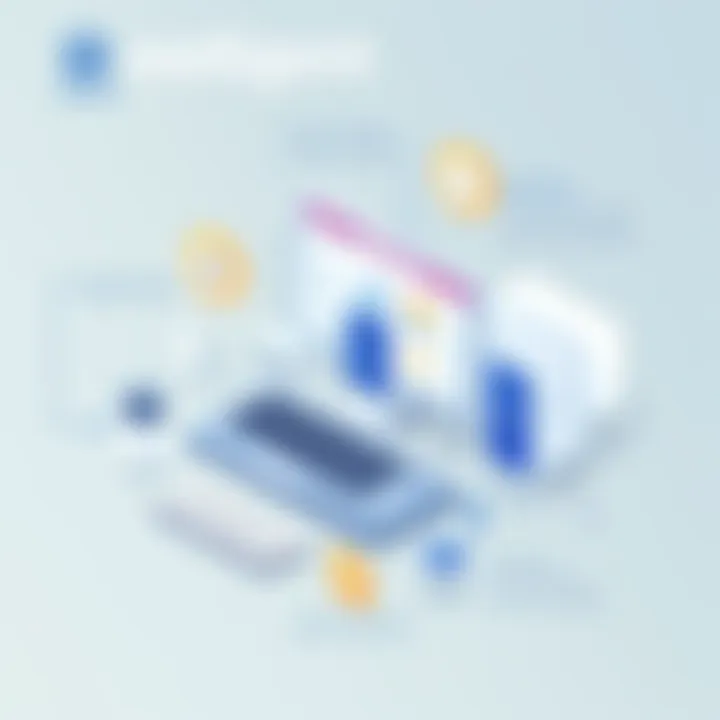Comprehensive Insights into Welligent Help Desk Solutions


Intro
In today's world, effective customer support is critical for the growth and reputation of any business. With numerous options available, selecting the right help desk software can be daunting. Among various solutions, Welligent Help Desk stands out by offering a blend of advanced features, user-friendly interface, and seamless integration capabilities. This section will unpack the essential components of Welligent Help Desk, illustrating not only its core functionalities but also its relevance in streamlining customer service operations for organizations across different sectors.
Understanding the offerings of Welligent Help Desk is crucial for decision-makers. With so many help desk solutions on the market, knowing the specifics of how Welligent operates can be the difference between quick resolutions or prolonged customer frustrations. In this exploration, we will highlight the features that make Welligent a reliable choice, dissect its pricing structure, and provide a comparative analysis against other help desk software. This comprehensive look aims to equip IT professionals and business owners with insights designed to inform and facilitate smart, strategic decisions.
Prolusion to Welligent Help Desk
In today’s fast-paced business environment, having an efficient way to manage customer support is nothing short of essential. To that end, Welligent Help Desk emerges as a prominent player in the field. This section focuses on what makes Welligent unique, its significance in optimizing customer support, and how it serves as a linchpin for organizations seeking to enhance their service quality.
Understanding Help Desks
Help desks have been around for decades, but their role has evolved significantly over time. Initially, they acted as a repository for customer complaints, but then they morphed into more dynamic platforms that handle inquiries, troubleshoot issues, and facilitate communication between businesses and their customers. At their core, help desks aim to simplify the process of providing assistance, making it easier for organizations to serve their customers better.
A modern help desk should encompass several key functions: ticket management, a comprehensive knowledge base, reporting tools, and a user-friendly interface. The ticketing system is akin to a digital triage process -- sorting out requests based on urgency, which ensures that critical issues receive attention without unnecessary delays.
Moreover, the knowledge base serves as both a learning tool and an asset for customer self-service. This functionality empowers users to find resolutions independently, reducing the strain on support staff and enabling them to focus on more complex tasks. Companies can expect this dual functionality to streamline their operations significantly.
The Role of Welligent in Customer Support
Welligent specializes in addressing the intricacies of customer support through a highly adaptive platform tailored to various industry needs. This adaptability is crucial as it allows companies from health care to education to leverage Welligent for improved service delivery.
One of the standout aspects of Welligent is its integrated ticket management system, which ensures that every customer inquiry is tracked and resolved efficiently. Businesses can apply specific criteria to prioritize tickets, allowing them to manage workloads effectively and avoid bottlenecks. This system aids in minimizing response times, a vital metric in customer satisfaction.
Welligent also emphasizes its robust reporting and analytics tools. These features empower administrators to derive insights from historical data, helping organizations recognize trends and areas for improvement. Decision-makers can analyze patterns in customer inquiries and adjust resources accordingly. Ultimately, Welligent provides not just tools, but a comprehensive framework to understand and enhance customer interactions.
In summary, Welligent Help Desk isn’t merely software; it’s an integral component to rework how businesses interact with their customers. By understanding its firepower in customer support, it's evident that organizations can turn their service challenges into opportunities for remarkable improvement.
Key Features of Welligent Help Desk
The heart of any help desk solution lies in its features. Welligent Help Desk offers an array of tools designed to streamline customer support processes. Each feature plays a vital role in enhancing both the efficiency of support teams and the overall experience for customers. In the competitive landscape of customer service, understanding the capabilities of Welligent can empower organizations to make informed decisions regarding their support infrastructure.
Ticket Management System
A robust ticket management system is akin to the backbone of a help desk. Welligent’s ticketing feature is designed to ensure that every customer inquiry is organized and tracked efficiently. Upon the submission of a request, it generates a unique ticket number that allows support staff to monitor the progress of inquiries from start to finish. This systematic approach not only aids in resolving issues but also provides customers with real-time updates on their concerns.
Moreover, it prioritizes tickets based on urgency, ensuring that critical issues are addressed promptly. This can be especially crucial in high-pressure environments, where response times can significantly impact customer satisfaction. To put it plainly, Welligent's ticket management system transforms chaos into order.
Knowledge Base Capabilities
An effective help desk isn't just about responding to queries; it’s also about empowering users with self-service options. Welligent puts a premium on this through its knowledge base features. This repository of articles, guides, and FAQs enables users to find answers to common questions without needing to engage customer support directly.
Imagine a customer curious about how to reset their password. Instead of waiting in line for a support representative, they can simply search the knowledge base at their leisure. This not only enhances user satisfaction but also allows your support team to focus on more complex inquiries. Furthermore, administrators can easily update this knowledge base to reflect new developments, ensuring that information remains fresh and relevant.
Reporting and Analytics Tools
In today’s data-driven world, the saying "What gets measured gets managed" rings true in customer support as well. Welligent’s reporting and analytics tools facilitate valuable insights into support operations. By analyzing key metrics such as ticket resolution times, customer satisfaction scores, and agent performance, businesses can pinpoint areas of improvement.
The tools not only highlight trends but also empower decision-makers to adapt strategies based on data. For example, if reports indicate a surge in tickets related to a specific product issue, teams can investigate and address the root cause proactively. This approach not only reduces repetitive queries but also fosters a culture of continuous improvement.
User-Friendly Interface
A slick interface can make all the difference in how effectively users can navigate a help desk tool. Welligent shines in this area, designed with usability in mind. The layout is intuitive, allowing both support agents and customers to find what they need with ease. This consideration for user experience can lead to quicker onboarding for new staff and a smoother ride for customers seeking answers. A user-friendly interface also minimizes training time and boosts efficiency right off the bat. When encountering a system that just works, both agents and clients feel more satisfied, enhancing productivity and reducing frustration.
The right features in a help desk solution not only streamline operations but also enhance satisfaction levels among users. Having all systems aligned paves the way for superior customer service experiences.
Each of these key features contributes to Welligent’s effectiveness as a help desk solution. By integrating the ticket management system, knowledge base capabilities, reporting tools, and a user-friendly interface, organizations can create a more responsive and efficient customer support environment. This layered approach not only addresses immediate concerns but also sets the stage for longer-term improvements.


Pricing Structure of Welligent Help Desk
Understanding the pricing structure of Welligent Help Desk is essential for organizations looking to enhance their customer service operations. The costs associated with implementing a help desk solution can significantly impact budget allocations and resource management. Knowing how various pricing plans are laid out, what's included, and how they align with your organization's needs can save time and money in the long run. The following sections will analyze specific pricing models and outline the value offered by each, assisting decision-makers in selecting the most suitable plan based on their requirements.
Overview of Pricing Plans
Welligent provides a range of pricing plans that cater to diverse organizational needs. Each plan aims to deliver critical functionalities while ensuring affordability. The tiered structure generally includes basic, standard, and premium packages, which differ in terms of features and support levels.
Key Considerations for Each Plan:
- Basic Plan: This entry-level option typically includes essential help desk functionalities such as ticket management and basic reporting tools. It’s suited for smaller organizations with minimal customer support needs or startups testing the waters with help desk software.
- Standard Plan: In addition to features of the Basic Plan, the Standard Plan often introduces enhanced reporting capabilities, a more advanced knowledge base, and better user support. This option strikes a balance for medium-sized businesses aiming for a bit more from their customer service tool.
- Premium Plan: The Premium Plan is the cream of the crop, offering a comprehensive suite of functionalities, including advanced analytics, API access for integrations, and possibly dedicated customer support. This plan is ideally suited for larger organizations that rely heavily on data-driven decision-making and require a seamless help desk experience.
Potential additional costs may arise based on specific needs, such as user seats or integration with external software platforms. Therefore, it's wise to review not just the base price but also these supplementary charges when considering which plan best aligns with your budget.
Value Proposition of Each Plan
Examining the value proposition of each pricing plan is crucial for drawing a clear distinction between them. While budgets are key, the ROI offered by each plan must also be taken into consideration. Let’s breakdown how each plan delivers value:
- Basic Plan:
- Standard Plan:
- Premium Plan:
- Cost-Effective Entry: Perfect for organizations just stepping into the help desk space, the basic plan offers a good starting point without breaking the bank.
- Essential Functionality: Provides core help desk functionalities, allowing for efficient ticket handling and customer interaction monitoring.
- Increased Efficiency: With enhanced tools, this plan helps businesses streamline operations, manage tasks better, and access improved reporting capabilities.
- Scalability: Ideal for growing teams that need more support, but aren't yet at enterprise-level scale, ensuring continued value as the organization grows.
- Comprehensive Tools for Data-Driven Decisions: Organizations can leverage advanced analytics to derive insights into customer interactions and support patterns, allowing for data-driven improvements.
- Integration Flexibility: Access to API for seamless integration with other software solutions provides greater functionality, transforming how support teams operate.
"Choosing the right plan not only depends on the price but should also focus on the value and flexibility each package offers to the organization."
Integration Capabilities
In today’s fast-paced digital landscape, businesses require software that can seamlessly integrate into their existing systems. The integration capabilities of Welligent Help Desk play a pivotal role in enhancing operational efficiency and ensuring that customer service representatives have the necessary tools at their fingertips. When considering a help desk solution, one must weigh the potential benefits of integration carefully. By facilitating a cohesive technological environment, Welligent helps in breaking down silos and promoting a more collaborative atmosphere.
Compatible Software Integrations
Welligent Help Desk is designed with adaptability in mind, which makes it easier to integrate with various software applications used across industries. Some of the compatible software integrations include:
- CRM Systems: Welligent works well with popular customer relationship management tools like Salesforce and HubSpot. This bridge connects customer service needs with sales and marketing efforts, ensuring a comprehensive view of customer interactions.
- Communication Tools: Integration with platforms such as Slack or Microsoft Teams allows teams to communicate effectively. Notifications and updates can be sent directly to these applications, reducing the need to switch back and forth between platforms.
- Social Media Platforms: By connecting with social media sites like Facebook and Twitter, Welligent enables organizations to manage customer queries that arise from these channels in real-time. This means that questions or concerns raised on social platforms can be captured and addressed promptly through the help desk.
The importance of these integrations cannot be overstated. Not only do they streamline processes, they also enhance productivity by allowing team members to access information and tools from a single location, thus reducing response times and improving customer satisfaction.
API Availability and Flexibility
Welligent provides robust API capabilities, which further expands its integration potential. The availability of a flexible API allows businesses to:
- Custom Integrations: For organizations with unique software stacks, Welligent's API enables custom integrations tailored to meet specific needs. This flexibility is crucial for accommodating specialized workflows that may not be supported by standard integrations.
- Automation of Tasks: Through API calls, repetitive tasks can be automated. For example, automatically generating reports or creating tickets based on specific triggers saves time and reduces human error.
- Data Synchronization: Ensuring that data remains consistent across various platforms is vital for decision-making. The API enables automatic updates and synchronization of information across applications, providing a single source of truth that enhances the reliability of the data an organization works with.
Utilizing Welligent's API can turn a cumbersome multi-software environment into an orchestrated system, making all connected tools work together in harmony.
With these integration capabilities, Welligent positions itself as not just a help desk but a central hub for managing customer interactions across various channels and tools, substantially enhancing operational efficiency.
User Experience and Feedback
Understanding user experience and feedback is crucial when it comes to evaluating solutions like Welligent Help Desk. In the realm of customer support, the perspective of actual users offers invaluable insights into how well a system operates and caters to its intended goals. Users’ experiences can reveal everything from usability to response times, shaping how organizations can enhance their customer service strategies.


Insights from Current Users
Many current users of the Welligent Help Desk have shared their thoughts. One recurring point is how intuitive the interface tends to be. Users often mention that they can navigate the system without needing extensive training. This ease of access helps teams dive straight into resolving customer issues instead of wasting time trying to figure out how to use the software.
For example, a tech support supervisor expressed satisfaction, stating, “With Welligent, I can see all my tickets at a glance. The layout makes it simple to prioritize.” This sentiment is echoed by various organizations, emphasizing how simplifying the user journey can lead to improved productivity.
Furthermore, collaboration features receive high marks. Users often appreciate how easy it is to communicate within the platform, thereby streamlining the troubleshooting process. A marketing team lead noted, “We love that we can comment on tickets and tag our colleagues. It reduces back-and-forth emails, which saves a lot of time.” Indeed, integrated communication seems to promote teamwork and efficiency, resulting in faster resolutions for customers.
Common Challenges and Solutions
No system is without hiccups, and Welligent Help Desk is no exception. Common challenges users face include occasional bugs and integration issues with other software. However, many have pointed out that these problems are met with responsive support from the Welligent team. Their customer service is often praised for being swift and effective, addressing concerns quickly to keep operations running smoothly a.a.s.p.
- Bugs in Ticket Routing
Many users reported difficulties regarding how tickets were routed to the appropriate department or support agent. Sometimes, requests would end up in the wrong queue, causing delays in responses. However, Welligent continues to update their software, which includes enhancing algorithms for ticket assignment. Users recommend staying updated with each release as the team actively works to iron out snags. - Integration with Third-party Software
While Welligent boasts strong integration capabilities, users sometimes find hiccups when syncing data with external tools. Yet, most agree that the ability to customize these integrations mitigates much of the hassle, allowing organizations to tailor solutions that fit their unique workflows. Users frequently suggest consulting the documentation provided by Welligent and reaching out if they hit any walls. Bouncing around community forums like those on Reddit can also yield some helpful tricks to streamline these processes. - Initial Setup Complexity
Many users felt the initial implementation took longer than expected, prompting some frustration. To counteract this during setup, engaging with the training resources and support options is essential. Users advise tapping into available tutorials or webinars to ease the onboarding process.
In summary, while there are challenges, the proactive approach from Welligent in addressing user feedback tends to foster a more positive overall experience. The strength of Welligent as a help desk solution lies in its flexibility and user-centric design, continually evolving to meet the needs of its users. Engaging in this feedback loop not only enhances customer satisfaction but also helps businesses thrive in a competitive landscape.
Comparison with Other Help Desk Software
In a landscape overflowing with help desk solutions, understanding how Welligent stacks up against its competitors is vital. For businesses aiming to enhance customer service, the choice of software can make or break the efficiency of their operations. This section dives into effective benchmarking practices and detailed insights about the strengths and weaknesses of Welligent Help Desk compared to other options available in the market.
Benchmarking Against Competitors
When examining help desk solutions, benchmarking plays an essential role. It allows organizations to gauge how well Welligent performs concerning prevalent features, user satisfaction, and overall efficiency. By making a direct comparison, businesses can discern the value of investing in Welligent over other alternatives.
The following key performance indicators often shape the assessment:
- Feature Set: Welligent provides a robust suite of tools that may include ticket management, reporting, and integration capabilities. Comparing these to other help desks lays the groundwork for discerning functional superiority.
- User Experience: The interface usability and overall user feedback can reveal critical insights into how smoothly the software operates in real-world scenarios. For instance, systems that prioritize ease of navigation often receive higher satisfaction ratings.
- Support and Resources: Evaluating customer support services can be significant in understanding how responsive the software providers are to their users’ needs. Welligent's approach to customer care may set it apart or highlight areas for improvement.
- Scalability: A help desk's ability to grow with the organization is crucial. Businesses should assess if Welligent can accommodate increased demands without sacrificing performance.
Conducting comprehensive research into these aspects enables decision-makers to align their choice of software with the specific needs of their organization.
Strengths and Weaknesses
Every tool has its pros and cons, and Welligent is no exception. Understanding the strengths and weaknesses of this software against its competitors is fundamental to making an informed choice.
Strengths:
- Comprehensive Feature Set: Welligent typically boasts a wide-ranging feature set that can cater to various industries, thus making it a versatile choice.
- Intuitive User Interface: Users have commended Welligent for its straightforward design, which can boost efficiency by reducing the learning curve.
- Excellent Integration Options: Welligent connects well with other software, enabling seamless workflows across platforms without a hitch.
- Strong Customer Support: Customer reviews frequently highlight the effectiveness of Welligent’s customer support, suggesting that issues can be resolved swiftly and professionally.
Weaknesses:
- Cost Implication: For smaller organizations, the pricing structure could be a double-edged sword. While the software offers various features, it may not be the most budget-friendly option compared with competitors.
- Learning Curve for Advanced Features: Some users have noted that while basic functions are user-friendly, more advanced functionalities can be cumbersome to master at first.
- Limited Customization: If a company requires highly tailored solutions, they may find Welligent somewhat restrictive in terms of customization capabilities compared with other tools that allow for greater flexibility.
In summary, while Welligent Help Desk carries notable strengths that support efficiency in customer service, it also presents challenges that must be taken into consideration. A careful evaluation against competitors will clarify whether this software aligns with your organization's goals and demands.
Implementing Welligent Help Desk in Your Organization
Implementing Welligent Help Desk is not just a checkbox on your to-do list. It’s a strategic move that can significantly transform the way your organization manages customer support. As customer expectations soar and competition intensifies, a solid help desk solution like Welligent can mean the difference between retaining customers and losing them. Here, we will delve into why implementing this software is essential, and what benefits, considerations, and steps should be taken into account.
Step-by-Step Implementation Guide
Just like assembling a piece of furniture from a store, deploying Welligent requires a methodical approach. Here’s a guide outlining crucial steps:


- Assess Organizational Needs: Before diving in, evaluate your current customer service processes. What are the gaps? Understand what problems Welligent seeks to solve.
- Define Objectives: Set clear, measurable goals. Are you looking to reduce response times? Increase customer satisfaction? Pin down what you hope to achieve with the implementation.
- Assemble a Project Team: Build a team that involves IT, customer service representatives, and other stakeholders. Their insights will be invaluable throughout the process.
- Install the Software: Depending on whether you choose a cloud-based or an on-premise solution, follow installation guidelines carefully. Ensure all technical requirements are met before installation.
- Customize Settings: Adjust Welligent’s features to fit your organization’s preference. This may involve tailoring ticket routing rules or setting up automated responses.
- Data Migration: Transfer existing data into the new system. This part can be daunting; therefore, keeping data integrity at the forefront is critical.
- Conduct Testing: Before going full throttle, run tests to catch glitches and ensure everything is functioning as it should. This step can save you headaches later on.
- Launch in Phases: A phased rollout allows you to iron out any issues in a controlled environment. Start with a specific department before expanding to the entire organization.
- Gather Feedback: After going live, collect feedback from users. Address any concerns promptly to guarantee they are comfortable with the new system.
- Review and Optimize: Continually analyze performance metrics. Fine-tuning processes based on feedback keeps your operations running smoothly.
Training and Support Options
Even the best software can fall flat without proper training. Welligent understands this and offers various training and support options to its users. Here’s what you might expect:
- Comprehensive Training Programs: Welligent provides customized training sessions typically available through webinars, video tutorials, and hands-on workshops. This approach ensures that users have a thorough understanding of the software.
- User Manuals and Documentation: Detailed user manuals serve as handy references. It’s prudent to encourage your team to familiarize themselves with these resources.
- 24/7 Customer Support: Accessible support is a must for help desk solutions. Welligent’s round-the-clock customer service via phone or chat ensures immediate assistance during critical hours.
- Community Forums: Engaging with other users through forums can yield valuable insights. You can share experiences and solutions, creating a collaborative environment.
"For successful implementation, remember: training is as critical as the tool itself. A well-trained team can leverage a solution to its full potential."
- Feedback Mechanisms: Encourage continual feedback on the training program. Adjust the training methods based on team members’ experiences, thus enhancing future training sessions.
The future of effective customer service definitely hinges on how well organizations implement tools like Welligent Help Desk. By approaching implementation thoughtfully and focusing on user training, businesses can realize the full potential of this robust help desk solution.
Culmination
In wrapping up our comprehensive exploration of Welligent Help Desk solutions, it is essential to emphasize how this tool contributes to enhancing customer support across various organizations. Understanding the functionalities and advantages of Welligent allows decision-makers to make more informed choices that align with their operational needs and strategic goals.
Summary of Benefits Provided by Welligent Help Desk
Welligent Help Desk packs an array of benefits that streamline customer service operations. Here’s a look at the key advantages:
- Enhanced Efficiency: By utilizing a robust ticket management system, Welligent enables teams to prioritize and resolve issues swiftly. This reduces response times and enhances overall service quality.
- Knowledge Base Utilization: With a rich knowledge base, agents can access commonly asked questions and solutions quickly. This capability not only speeds up the support process but also empowers customers to help themselves through self-service options.
- Insightful Reporting and Analytics: The built-in reporting tools allow for data-driven decision making. Organizations can delve into performance metrics, identifying trends and areas for improvement, ultimately driving better customer satisfaction.
- User-Friendly Interface: The platform’s design is intuitive, making it accessible to users with varying levels of technical skill. This ease of use ensures that teams can focus more on customers rather than struggling with software complexities.
- Seamless Integrations: Welligent’s ability to integrate with existing systems means that businesses can maintain their current workflows without disruption, which ensures a smooth transition and continued operational efficiency.
Final Thoughts for Decision Makers
In today’s fast-paced business environment, the need for responsive and effective customer support can’t be understated. Welligent Help Desk stands out as a solution that not only meets these demands but exceeds expectations in several areas.
When considering the adoption of a help desk solution, it's crucial for decision-makers to weigh these elements thoroughly:
- Your Unique Needs: Every organization has different requirements. Assess how Welligent’s capabilities align with your specific processes and customer interaction needs.
- Scalability and Growth Potential: As organizations evolve, so do their support requirements. Opting for Welligent means banking on a system that can grow alongside your business.
- Cost versus Value: Evaluate the pricing structure in connection with the features delivered. A higher investment upfront can mean more significant savings and efficiencies down the road.
Ultimately, Welligent Help Desk can be a powerful ally for those aiming to refine their customer support strategies. By understanding its features and benefits, you ensure that your organization is well-equipped to deliver outstanding service that resonates with customers, builds loyalty, and drives success.
"Investing in a robust help desk solution today can lay the groundwork for unparalleled customer satisfaction tomorrow."
For further insights, resources like Wikipedia and TechCrunch may offer additional information on help desk solutions.
Future of Help Desk Solutions
As we move into an era dominated by technology, the future of help desk solutions stands to be significantly transformed. With rapid advancements in consumer tech, the strong>>importancestrong>> of modern help desks becomes apparent. These solutions are not just about resolving queries; they’re about offering seamless experiences that integrate with the communication and problem-solving styles favored by today’s users.
Trends in Customer Support Technology
In the realm of customer support technology, several trends are making waves:
- AI-Powered Solutions: Artificial intelligence continues its proliferation. Chatbots and virtual assistants are increasingly capable of handling basic queries, thereby freeing human agents for more complex issues. This shift not only enhances efficiency but also improves response times.
- Omnichannel Support: Customers expect consistency across all platforms. Whether they reach out via social media, email, or phone, they want uniform quality of service. Thus, integration of channels and data is crucial for help desks to meet these expectations.
- Self-Service Portals: There’s a growing preference among customers for finding answers on their own. Help desks now often feature comprehensive knowledge bases that allow users to troubleshoot issues before needing to contact support.
The importance of these trends lies in their potential to streamline responses, boost customer satisfaction, and maybe even cut operational costs for companies who adapt effectively.
Innovations on the Horizon
As we look ahead, several innovations are on the horizon that promise to reshape the help desk landscape further.
- Predictive Analytics: By harnessing the power of predictive analytics, help desks can anticipate problems before they arise. This proactive approach allows for interventions that can prevent customer dissatisfaction from ever occurring.
- Integrating Augmented Reality: Imagine a customer in their home being able to receive real-time assistance via augmented reality. Whether it’s for tech support or complex machinery fixes, this technology is on the brink of becoming mainstream.
- Blockchain for Transparency: Utilizing blockchain technology can enhance the security of sensitive customer interactions and ensure data integrity. As trust becomes increasingly essential in customer relationships, such innovations could be a game-changer.
"The future belongs to those who prepare for it today." - Malcolm X
As decision-makers ponder the next steps, understanding these developments will be key to leveraging the full potential of help desk solutions.







